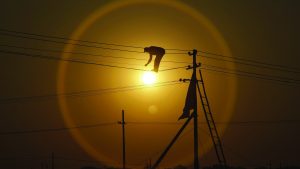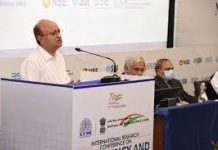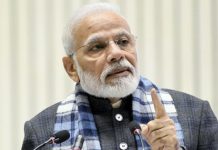 All households in the country are likely to be electrified by March 31, 2019. If the claim of Union Minister of State, R.K.Singh is to be believed “Country is on the path to achieving 100 per cent household electrification by 31 March 2019 and the next goal is the 24×7 power supply for all households”. RK Singh Union Minister of State (IC) for Power and New & Renewable Energy has complimented States for electrifying 2.5 crore households under Saubhagya in a record time of 17 months.
All households in the country are likely to be electrified by March 31, 2019. If the claim of Union Minister of State, R.K.Singh is to be believed “Country is on the path to achieving 100 per cent household electrification by 31 March 2019 and the next goal is the 24×7 power supply for all households”. RK Singh Union Minister of State (IC) for Power and New & Renewable Energy has complimented States for electrifying 2.5 crore households under Saubhagya in a record time of 17 months.
This information came to light while Singh was addressing the inaugural session of the Conference of Power and Renewable Energy Ministers of States and UTs at Gurugram on February 27. The two-day Conference has been called to review the implementation of various ongoing Schemes/ Programmes and deliberate on a host of issues pertaining to Power and Renewable Energy sectors.
Power Minister also felicitated State Power Departments and DISCOMs for their achievements under Saubhagya. Laying the roadmap for achieving 24×7 power for all, Singh said that this will be done by strengthening the distribution network, improving the DISCOMs health, reducing the transmission & distribution losses, using technology to improve billing and collection efficiency and energy efficiency. However, the hours of power supplied to the agriculture sector will be as per the state’s policies so as to reduce water wastage and prevent over-exploitation of our already stressed groundwater resources. Addressing the conference, Ajay Bhalla, Secretary, Power invited the States/UTs to share their views and work together to find solutions to the challenges faced by the Power Sector.
The Ministers and Secretaries of the States and Union territories and senior officials of the power & renewable energy sectors and Public Sector Undertakings are attending the Conference under them. In the next two days, the delegates will discuss issues like- 24×7 Power For All, present situation analysis of thermal power, Intra-state and Inter-state transmission status, promoting energy efficiency and renewables for a less carbon-intensive economy. New reforms such as UDAY-II — use of technology, improving metering/billing/collection and solar irrigation will also be discussed during the conference.
India is all set to achieve 100 percent household electrification under the 16,320 crore Saubhagya scheme. The Pradhan Mantri Sahaj Bijli Har Ghar Yojana (Saubhagya) was launched in September 2017. Around 30,000 families are being provided with electricity connection every day. Therefore, the remaining around four lakh households could be energised by the end of March 2019.
Achieving 100 percent of household electrification was one of the aims of the present government. However, it could not meet the self-imposed deadline of December 2018 for the scheme.
At a meeting of state power ministers, chaired by Union Power Minister R K Singh in Shimla in July 2018, it was resolved to complete the task of energizing all households by 31 December 2018, against the original deadline of 31 March 2019 provided under the Saubhagya scheme. It was again put off and the new deadline is March 31, 2019. Elaborating about the reason for left out unelectrified households, the minister said that the work was affected in Chhattisgarh due to left-wing extremism or Naxal issues because they do not allow electricity supply which can connect people in those areas to the outside world. He further said that the left out households in Rajasthan are at far off places but efforts are on to complete the task by March 31, 2019. On the issue of payment security mechanism for private sector power generators as suggested by the high-level committee on stressed power assets, the minister said that the recommendations are under consideration and the government would discuss it with the RBI before going ahead.
Talking about the infusion of renewable energy, he said that clean energy share would increase in future but the coal-based power would stay for some time because demand would further increase with the addition of 2.5 crore new subscribers and economic development. On coal shortage, he informed that coal reserves at power plants are for 12 to 13 days at present and the power ministry is discussing the issue with coal and railway ministries to improve supplies in view of increasing power demand.
The minister also claimed that the present government has re-energised 3.3 lakh villages in the country which were electrified earlier. About 24X7 power for all objectives, he said that the government has allocated 1.6 lakh crore for strengthening distribution network in the country and the objective would be achieved as lot work is being done and there is a requirement for equipment like poles, cables to implement that. The minister also asked the states to implement the environment norms for power plants by 2024 as after that the non-compliant units would be closed down. The environment ministry has prescribed strict norms for sulphur and nitrogen emission from coal-based power plants.
Laying the roadmap for achieving 24X7 power for all, Singh said that this will be done by strengthening the distribution network, improving the DISCOMs’ health, reducing the transmission & distribution losses, using technology to improve billing and collection efficiency and energy efficiency.
The Saubhagya scheme envisages providing last mile connectivity and electricity connections to all remaining households in rural as well as urban areas. Under the scheme — Pradhan Mantri Sahaj Bijli Har Ghar Yojana, Saubhagya the households are identified via the Socio-economic and Caste Census (SECC) of 2011 and are provided with free electricity connections and others were charged a nominal fee of Rs 500. The scheme aims at providing last mile connectivity and electricity connections to all remaining households in rural and urban areas.
Star Labeling launched
During the inaugural R K Singh also launched Energy Efficiency Label for residential sector in India. Developed by Bureau of Energy Efficiency (BEE), this under the aegis of Ministry of Power Energy efficiency label programme, for residential buildings will provide the information to consumers on the energy efficiency programme standard of the Homes to be constructed across India.
The objective of the labeling programme is to make an instrument over the energy performance of a home, which will gradually lead to an effective tool while deciding over the home prices in the future. It also aims to provide a benchmark to compare one home over the other on the energy efficiency standards so as to create a consumer-driven market transformation solution for Energy Efficiency in the housing sector.
The proposed labeling program is expected to save a substantial amount of electric energy through various energy efficiency efforts in houses
nationwide. With the implementation of Energy efficiency label for residential buildings, it is estimated to achieve an energy saving of up to 40 per cent over the conventional houses with annual savings of 90 Billion Units by the year of 2030. Further, the Labeling mechanism will reduce energy bills for homebuyers. The likely CO2 emission deduction by 2030 will be 320 MT CO2 annually.
letters@tehelka.com













